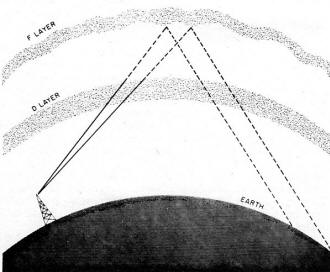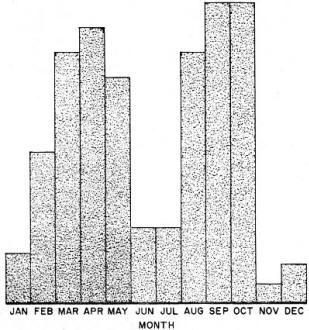Predicted Radio Receiving Conditions
|
|
How the short-wave bands will be in March and April plus some information on the poor conditions expected During ionospheric storms the normal day-to-day structure of the reflecting layers undergoes immense changes. Particles from the sunspots are caught in the earth's magnetic field and find their way into the ionosphere. The F layer (responsible for most long-distance radio communication) is weakened. Signals either pass through this layer into space or are weakly reflected. The D layer absorbs an abnormal number of radio signals passing through this region, further reducing signal strengths. Sunspots, or explosions on the surface of the sun, are caused by factors unknown to us at this time. These explosions release a shower of particles that have been recorded by satellites launched specifically for this purpose. The particles do not travel with the speed of light and seemingly take 20-30 hours to reach the earth. Scientists refer to the spreading out of particle streams as a "garden hose" effect. Severe ionospheric storms will occur in March. The relative number of ionospheric storms varies according to the month, or season of the year. It also varies with sunspot activity - more sunspots mean more ionospheric storms. Ionospheric disturbances are more frequent during the equinox due to the position of the earth in its orbital plane. WWV Propagation Forecasts. To enable users of the ionosphere, SWL's included, to keep track of the latest radio conditions, the Central Radio Propagation Laboratory of the National Bureau of Standards issues short-term propagation forecasts four times daily, at 0000, 0700, 1200, and 1800 EST. These forecasts give estimates of radio quality over North Atlantic transmission paths, such as between London and the eastern United States. However, the forecasts are generally applicable to other paths, particularly during good propagation conditions. Although these forecasts are revised every five to seven hours, they are repeated every five minutes by NBS Station WWV, in International Morse Code, on 2.5, 5, 10, 15, 20, and 25 mc. Each forecast is broadcast unchanged until the regularly scheduled revision comes on. The forecasts consist of a letter and number; the number is the forecast, while the letter identifies the quality of radio-propagation conditions prevailing at the time the forecast is issued. The numbers used have the following meanings: 1 - useless; 2 - very poor; 3 - poor; 4 - poor to fair; 5 - fair; 6 - fair to good; 7 - good; 8 - very good; 9 - excellent. The radio quality at the time the forecast is issued, based on the average quality of conditions in the two hours preceding its issue, is identified as follows: W - Warning. Disturbed conditions (quality 1, 2, 3, or 4) exist. U - Unsettled. Quality 5. N - Normal. Quality 6, 7, 8, or 9. A typical forecast statement would be "U-6," which means that propagation conditions are now unsettled but radio quality is expected to improve to "fair to good" (6) during the period covered by the forecast. By Stanley Leinwoll, Radio Propagation Editor Major international short-wave broadcasting schedule changes will become effective Saturday, March 6, at 2000 EST. Here is a summary of expected conditions in the high-frequency bands for March and April. 11 Meters. Because of the low level of sunspot activity, ll-meter signals cannot be propagated via sky wave during the spring season. None of the short-wave broadcasters have scheduled transmissions in this band. 13 Meters. Activity in this band is ex-pected to be below winter levels. Principal users will be the Voice of America and the BBG between the hours of 1000 and 1800 GMT (0500-1300 EST). Interesting DX possibilities in this band include Ghana on 21,530 kc. between 0900 and 1100 EST, Aus-tralia' on 21,540 kc. from about 2000 EST, and Pakistan on 21,590 kc. between 0500 and 0900 EST. 16 Meters. Fairly good DX'ing should be possible throughout much of the day. Considerable use of this band will be made by the Europeans from early morning to shortly after noon, EST. Ecuador, on 17,890 kc., is about the only Latin-American country scheduled to broadcast in this band, and the best time for reception is around 1500 EST. Congo, on 17,720 kc., during the period from 0800 to 1000 EST, is another attractive possibility. 19 Meters. This band will be most pro-ductive for DX during the daylight hours, from very early morning to evening, with reception from all parts of the world pos-sible at some time during the period when the band is open. During the morning hours until mid-afternoon (EST), for example, reception should be good from Europe, Africa, the Near East, and Latin America. During the late afternoon and evening, re-ception will improve from Asia and Aus-tralia, and continue from Latin America. 25 Meters. Conditions in this band will improve over those observed during the winter, when DX to many parts of the world was relatively poor. In the spring, the ionosphere begins to stabilize-usable night-time frequencies get higher, while optimum daytime frequencies get lower. This sea-sonal trend makes the 25-meter band useful for longer periods of time. In general, re-ception from Europe, the Middle East, and Africa should be possible during middle to late afternoon, local time. During the eve-ning hours, the Latins will be predominant, while best DX possibilities from the Pacific should exist during the morning hours. 31 Meters. The seasonal trend toward higher usable nighttime frequencies will re-sult in improved conditions in this band. Reception from Europe, Asia, and Africa should be possible from mid-afternoon into the evening hours, when South and Central American stations will dominate. During the mid-morning hours, reception of sta-tions to the west will be best. Among the better DX possibilities in this band are Ku-wait on 9520 kc., Guinea on 9650 kc., Senegal on 9720 kc., and Israel on 9725 kc., all during the afternoon hours, EST. 41 and 49 Meters. These bands will open up for DX reception during the late after-noon hours, local time, and will remain open from one area of the world or another throughout the night. Although interference levels will not be quite as bad as they were during the past winter, they will neverthe-less be serious enough to hamper many of the better DX catches. Some stations, how-ever, should be exceptionally strong during the late evening hours. In general, DX re-ception should begin during the afternoon from stations in Europe, the Middle East, Asia, and Africa. The distant Latins will start coming in shortly afterward. For the late night DX'ers, signals from the east will start going out several hours before dawn. Stations from the Pacific should be heard at this time, and should continue to be heard until several hours after sunrise. 60 and 90 Meters. Conditions will deteri-orate in the spring. During the past winter, the combination of low sunspot activity and a record number of users made DX reception in these bands the best in history. With the approach of summer, static levels will increase and signals will grow weaker. However, there will still be a few good DX openings during the hours of darkness. Standard Broadcast Band. The record-breaking DX conditions observed during the winter months have come to an end. Sig-nals in the standard broadcast band are growing weaker, and noise levels are in-creasing. This trend should continue as the season progresses, nights grow shorter, and maximum usable frequencies increase. Good DX will still be possible, but for shorter periods of time, and not nearly to the extent observed in December and January. Long-Wave Band. Some interest has been expressed in reception of signals in the long-wave band, between 150 and 285 kc. The Geneva Radio Regulations of 1959 allocate this band to AM broadcasting in Europe, Africa, and part of Asia. Long-wave broad-casting is fairly popular in Europe, although not as popular as medium-wave (or what we call "standard") broadcasts. In general, long-wave propagation is similar to medium-wave propagation: conditions at night are much better than during the day, and propagation in winter months is better than in the summer. One problem with reception of long-wave broadcasts that is more serious than in any other part of the spectrum is the type of antenna required. Wavelengths in the kilocycle range are extremely long, being on the order of about one mile at 180 kc. This means that a simple half-wave dipole antenna would have to be half a mile long at this frequency to be effective. Listeners cannot be expected to erect such antennas, so a fairly long wire must do, which means a loss of signal strength. This fact - coupled with the fact that as we go down in frequency, static levels and absorption in the ionosphere increase - results in reception that is generally inferior to that in the medium-wave broad-cast band. Ionospheric Storms. From time to time disturbances occur in the upper atmosphere which tend to disrupt long-distance communications by severely upsetting the stability of the ionosphere. Such disturbances are most likely to occur during the spring and fall equinox - March and April, and September and October - when the earth passes through the plane of the sun's equator. They fall into two general categories: the ionospheric storm and the sudden ionospheric disturbance (SID). Ionospheric storms usually develop gradually and continue from several days to almost a week. The SID, on the other hand, commences suddenly, and seldom lasts more than an hour. Although they are different in nature, both disturbances have the same effect on communications: during storms, signal levels fall off sharply, fading becomes se-vere, and the general quality of DX reception deteriorates. During extreme conditions, a radio blackout may occur during which it becomes impossible to maintain high-frequency communication with many areas of the world. During the early days of radio (the 1920's), it was not unusual for SWL's and amateurs to rip their receivers apart during radio blackouts because they thought something had gone wrong with the sets. Nowadays, we know better. Ionospheric storms are caused by bursts of radiation from the sun. This radiation, composed of either extremely intense ultraviolet radiation, or subatomic particles from an explosion on the sun, or both, saturated the ionosphere, resulting in a tremendous increase in radio-wave absorption, which in turn results in a sharp decrease in signal levels.
Posted March 7, 2018 |
|




